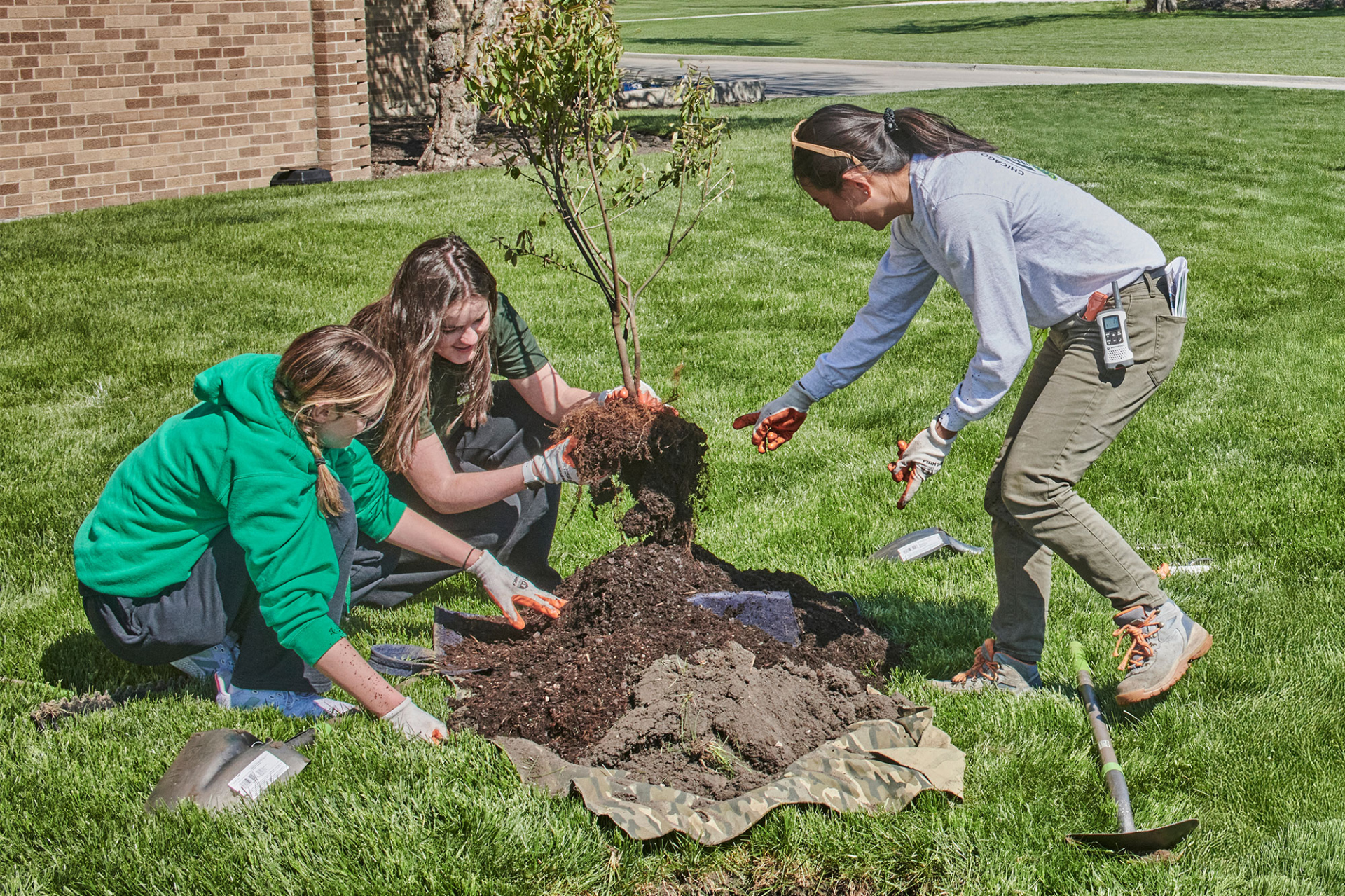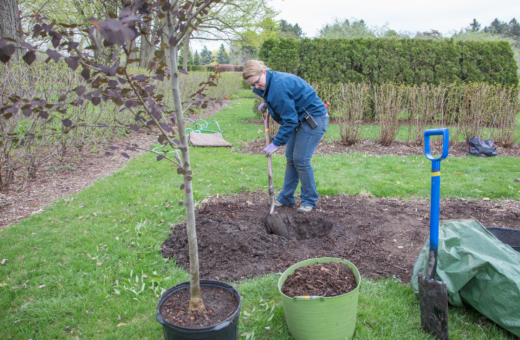Working for Trees Where People Live
Ten years ago, The Morton Arboretum set out to tackle some big problems in a big way by founding the Chicago Region Trees Initiative (CRTI). In the decade since, it has become one of the nation’s foremost urban and community forestry programs.
“The Arboretum has applied the power of data, collaboration, and expertise to preserve and improve the tree canopy,” said Murphy Westwood, PhD, vice president of science and conservation. “CRTI has become a major force for environmental stewardship and capacity building.”
The program was founded in 2014 to address serious issues exposed by the first census of trees in the seven-county Chicago region. The 2010 survey, led by the Arboretum and the USDA Forest Service, had revealed that the region had much less tree cover than the national average. The trees that did exist were not equitably distributed, with far more trees growing in wealthy and predominantly white neighborhoods and suburbs.
The tree species were not diverse, with invasive European buckthorn accounting for a third of the region’s trees. There were too few oaks, once the region’s dominant tree group, and far too many maples, making them vulnerable to potential new pests or insects.
To tackle such large, complicated, long-range regional problems, the Arboretum, along with the Chicago-based land trust Openlands, started CRTI to bring together partners including environmental nonprofits, government entities, tree care professionals, volunteers, natural areas managers, and community members.
“One of the critical factors in the success of the program is that we are very collaborative and very inclusive,” said Zach Wirtz, CRTI’s director. “We talk with people and through listening we learn from them. We know we can’t do all the work, nor should we.”
Equity—prioritizing people and communities that don’t have enough trees because of historic injustices—was a core concern from the beginning. The Arboretum’s CRTI staff came at the problem with data, identifying communities where the need for trees was greatest by developing maps that correlate existing tree cover with U.S. Census demographic data. They also compared this information to data that measured problems that more trees could help combat, such as poor air quality, flood risk, and urban heat island effect.

Bringing trees and equity to neglected communities is a central focus of the Arboretum’s urban and community forestry program.
The maps provide facts to back up local advocates’ efforts to expand municipal tree care budgets, improve local tree protection laws, plant more trees, fight invasive species, and build support for trees. “Trees need champions in every community—a person or organization that will stand up for them, care for them, and educate the people around them about their importance,” Wirtz said.
The Arboretum program’s efforts are wide-ranging. For example, the initiative leads in implementing a regional plan to help oak trees recover their once-dominant place in the ecosystem of the Chicago region. An online tool helps municipalities develop ordinances to protect trees. Through CRTI, the Arboretum also has coordinated a carbon credit program through which companies can invest in tree planting and preservation.
By fostering networks among arborists, municipalities, and nurseries, the Arboretum has influenced tree care practices. Urban Forestry Basic Training is a tree care boot camp for maintenance workers who find themselves caring for trees as part of their jobs with public works departments, school districts, transportation agencies, and other employers that do not specialize in trees.

Urban Forestry Basic Training spreads best practices in tree planting and other skills.
In priority communities in the city of Chicago, the Arboretum, working with the city’s Our Roots Chicago initiative, trains and funds community-based Tree Ambassadors to encourage residents to advocate for trees and find sites to plant trees on parkways. The CRTI staff also works with nurseries to encourage them to grow a more diverse range of trees that are more likely to be able to withstand invasive pests and the stresses facing urban trees because of a changing climate.
Of course, CRTI plants trees—more than 2,600 in 2023. Specifically, staff members help local people, through neighborhood groups, municipalities, schools, faith communities, and many other entities, to organize volunteer tree plantings. CRTI also helps to supply trees, tools, and expertise. These plantings do more than add to the tree canopy, Wirtz said: “They set an example and inspire people to plant and care for trees. By training and inspiring people to become tree champions in their own communities, they exponentially amplify the Arboretum’s impact.”
The program also helps communities obtain government and nonprofit grants for planting, tree inventories, and improvements in tree care management.
It was partly that experience that led to a huge expansion of the program’s reach in 2023: The USDA Forest Service and the Illinois Department of Natural Resources chose The Morton Arboretum to administer more than $23 million in urban forestry funding from the federal Inflation Reduction Act over five years. Public entities and community groups across Illinois, particularly in disadvantaged communities, are using these grants to plant and care for trees and to foster public engagement and understanding.
Many local communities that have applied for grants have insufficient staff and expertise in forestry, and they turn to The Morton Arboretum for guidance “to make their projects successful and sustainable,” Wirtz said. “That’s money that is flowing through the Arboretum to help people and trees throughout Illinois.”

The Community Tree Network brings together tree professionals and community members to share knowledge.
There is a long way to go to reach the program’s goal of a healthier, more diverse, more equitable urban forest. The Arboretum’s 2020 Chicago Region Tree Census found that although the region had more trees than in 2010, the invasive buckthorn problem had actually gotten worse over the decade. Addressing such problems facing trees requires the kind of long-term commitment the Arboretum can provide.
As more needs and possibilities have become apparent, the Arboretum’s CRTI staff has grown from two to nearly 20. “We now have the capacity to really build on the momentum of our first 10 years,” he said.
Wirtz, who succeeded CRTI’s first director, Lydia Scott, in 2024, is hoping the Arboretum program can provide a model for regional forestry partnerships across the country.
One example of its growing influence was the recent appointment of Arboretum staffer Trinity Pierce, CRTI senior stewardship manager, to the National Urban and Community Forestry Advisory Council of the forest service. The council oversees the National Urban and Community Forestry Program and provides recommendations to the U.S. Secretary of Agriculture and other government agencies on urban natural resource management and federal funding priorities.
“The Arboretum is making a substantial impact through community forestry,” Westwood said. “Through the CRTI program, we are working to ensure that all the people of the Chicago region and Illinois receive the important benefits of trees where they live.”



